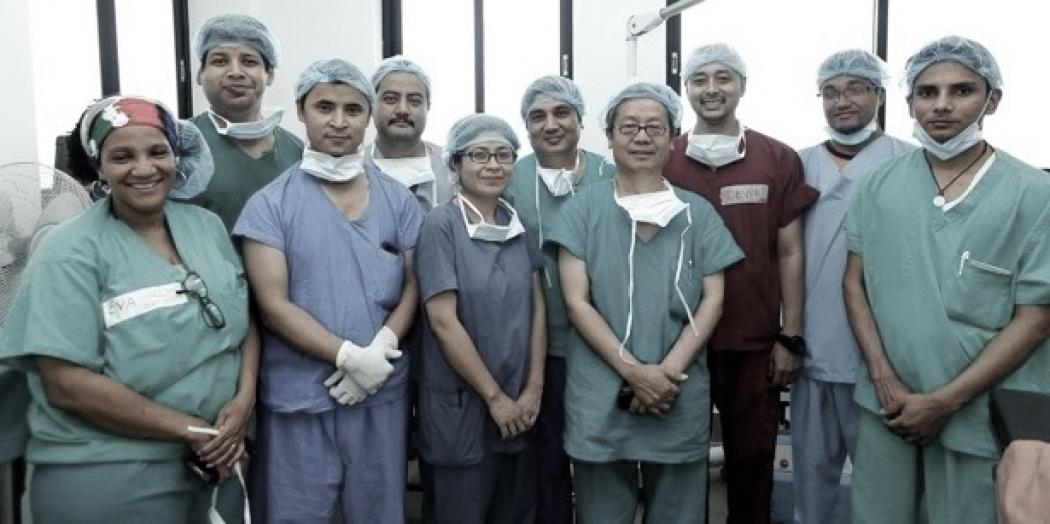Building the frontline surgical workforce needed to deliver global health progress, drive economic growth

Photo courtesy of ReSurge International.
By Sara Anderson, ReSurge International
In May 2017, two important anniversaries will be noted: the earthquakes in Nepal and the passage of World Health Assembly (WHA) Resolution 68.15, acknowledging the critical role of strengthening emergency and essential surgical care and anesthesia as part of universal health coverage (UHC). While these events may seem unrelated, one illustrates the importance of the other.
The photo above was taken soon after the Nepal earthquakes. It is of the ReSurge Nepal surgical team, the largest reconstructive plastic surgical team in Nepal, with nine of the country’s 16 reconstructive plastic surgeons. With our local partner NGO, they treated more than 800 earthquake victims in the recovery.
ReSurge Nepal was able to immediately care for the injured after the earthquakes because of the investments we made in surgical capacity and health workforce. ReSurge’s investment in training began in the early 1990s, with Dr. Shankar Man Rai, who was a young resident then. With our training and support and Dr. Rai’s leadership, ReSurge Nepal now restores the lives of thousands by providing the reconstructive surgical care needed year-round.
Yet, further investments and health workforce training must be made to counter the extreme shortfall of surgical access in low-income countries, including Nepal. Although thousands are now receiving care in the country, millions are still without access.
According to the Lancet Commission for Global Surgery, as many as 5 billion people do not have access to safe, affordable surgical and anesthesia care, with only 6% of all surgical procedures benefiting the world’s poorest third.
Surgical conditions – from trauma, obstetric conditions, and infectious and non-communicable diseases – represent approximately 30% of the global burden of disease.
Contrary to popular belief, surgical care is as cost effective as many other public health initiatives -- $82 per disability-adjusted life years (DALY) for general surgery vs. $52 per DALY for BCG vaccine for tuberculosis prevention and $454 per DALY for antiretroviral drugs to treat HIV/AIDS. The World Bank’s Disease Control Priorities (DCP3) states that “essential surgical procedures rank among the most cost-effective of all health interventions.” For every $1 spent on strengthening local surgical capacity, $10 is generated through enhanced health and increased productivity, according to a United Nations’ report.
Access to surgical care is also a critical component of health systems strengthening, UHC and fulfilling the Sustainable Development Goals. Inherent in the framework of a sustainable health system is access to safe surgical care. Non-communicable diseases kill 38 million people around the world every year, and surgical conditions make up a significant proportion of this burden. For example, 60% of all cancers require a surgical intervention.
Moreover, there is a shortage of 1 million surgical, anesthesia and obstetrical specialists in low- and middle- income countries.
By 2030, the Lancet Commission estimates that this workforce must double to sustain the maintain status-quo, let alone account for increases needed to address the unmet burden of surgical disease.
This critical shortage of surgical health workforce, coupled with the unmet need of 5 billion people, motivated the world’s health ministers in May 2015 to recognize that strengthening surgical and anesthesia care is essential to universal health coverage; their resolution was unanimously adopted, with strong support of the United States. And just as the WHA recognized that surgical care is essential to a complete health system, the WHA also recognized that such a robust health system depends on a comprehensive global health workforce on the frontlines of care, from community health workers to nurses to surgeons. The UN Secretary General’s High-Level Commission on Health Employment and Economic Growth recently called for investment in a “fit-for-purpose health workforce” to stimulate economic growth, promote gender equality and the strong global workforce necessary to achieve the SDGs.
A relatively small investment in building surgical capacity in Nepal has already made a significant impact. The impact of surgical training is long-term and exponential..
Imagine if the US and countries around the world also invested in a robust global health workforce, as recommended. Could there be a better investment? As Dr. Richard Horton, editor of the Lancet, explained,
"Contrary to a half-century of consensus among economists, investing in health—and specifically health employment—is good, not only for health but also for the economy.... Investing in the health workforce is not a ‘cost disease’ at all. On the contrary, investing in health workers improves the growth rate of economies."
Note: The G4 Alliance’s Mira Mehes and Lauren Baumann, as well as the research of the Lancet Commission on Global Surgery, contributed to this article.
